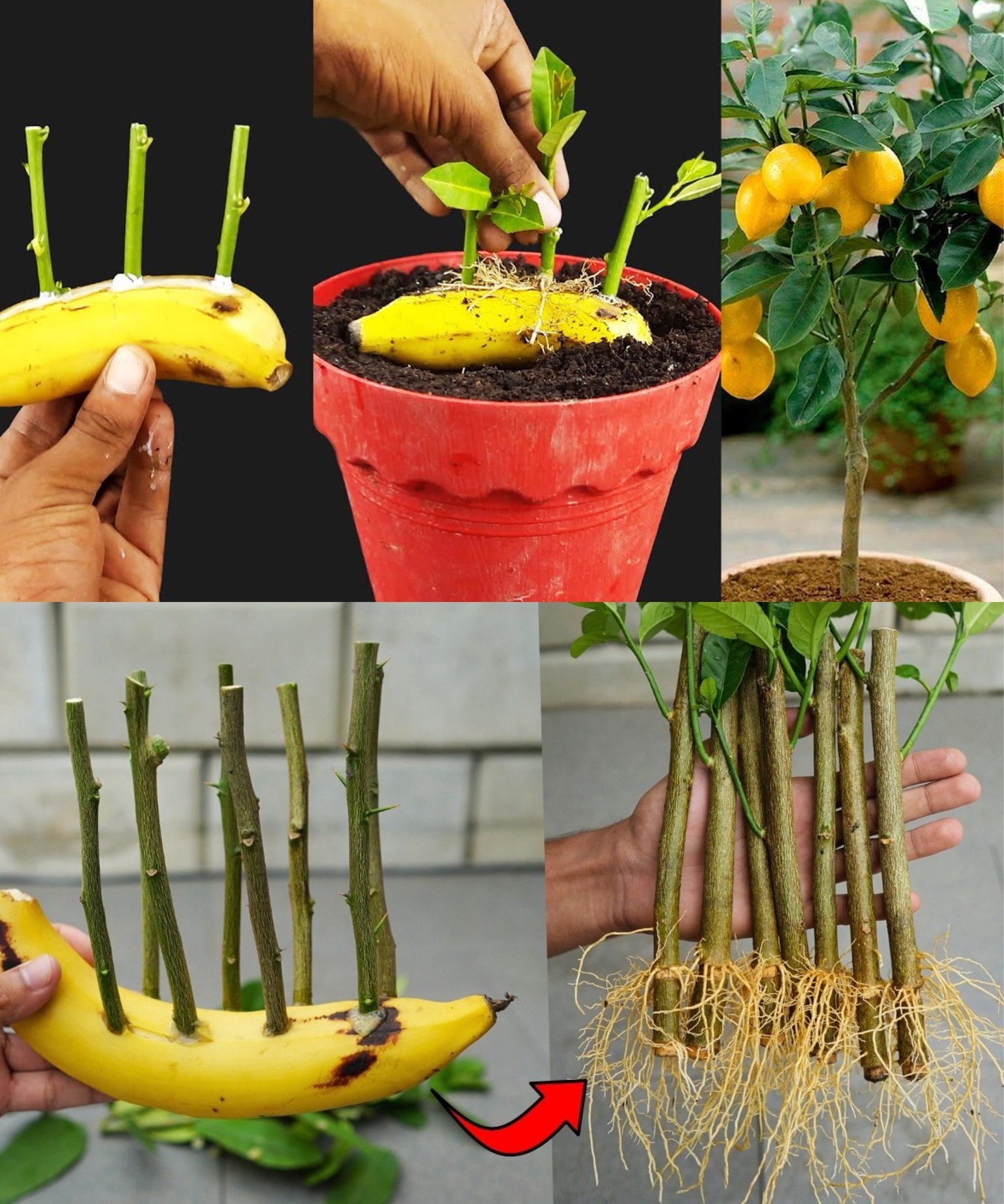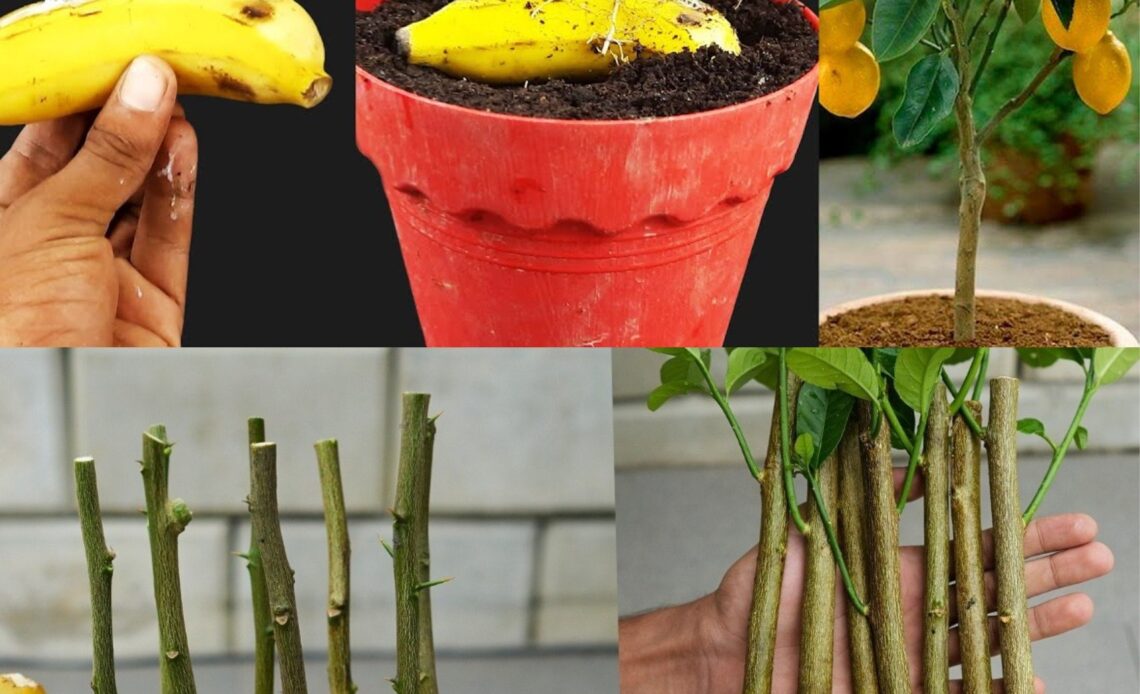Lemon trees are a fantastic addition to any home garden, offering fresh, tangy fruit and a fragrant atmosphere. However, growing them from cuttings can be a challenge, as cuttings often struggle to develop strong roots. Fortunately, there’s a simple and natural method that can help—using bananas This surprising trick can accelerate root development, making the process of propagating lemon trees easier and more effective. In this guide, we’ll explore how bananas can be used as a natural rooting enhancer and provide a step-by-step process for successfully growing lemon trees from cuttings.
## Why Use a Banana for Lemon Tree Propagation?

Most gardeners rely on synthetic rooting hormones to promote root growth in cuttings, but a banana offers a completely natural alternative. Bananas are rich in essential nutrients like potassium and phosphorus, which are known to encourage root development. Additionally, their soft, moist texture helps keep cuttings hydrated, creating an ideal environment for new roots to emerge.
### The Benefits of Using Bananas:
1. **Natural Root Growth Booster** – Bananas contain key nutrients that stimulate root development, helping lemon cuttings establish themselves faster.
2. **Eco-Friendly Solution** – This method avoids synthetic chemicals, making it a safe and environmentally friendly way to propagate plants.
3. **Retains Moisture** – The moisture in bananas helps prevent cuttings from drying out, increasing their chances of survival.
4. **Easy and Affordable** – Since bananas are a common household item, this method is accessible to anyone looking to grow lemon trees at home.
Now that we understand the benefits, let’s dive into the process of propagating lemon trees using this banana trick.
## Step-by-Step Guide to Growing Lemon Trees with Bananas

### **Step 1: Select a Healthy Lemon Cutting**
To ensure successful propagation, start with a healthy branch from a mature lemon tree. Look for a semi-hardwood cutting that is about 6–8 inches long with multiple leaf nodes. Cut at a 45-degree angle using sterilized pruning shears. Remove any flowers or excess leaves, leaving only a few at the top to reduce moisture loss.
### **Step 2: Prepare the Banana Rooting Medium**
Take a fresh banana and cut a small section, approximately 2 inches long. Create a hole in the banana piece large enough to fit the bottom of the lemon cutting. This will allow the cutting to absorb the nutrients and moisture from the banana.
### **Step 3: Insert the Cutting into the Banana**
Carefully insert the cut end of the lemon cutting into the hole you made in the banana. Ensure that the cutting is snugly secured, allowing it to absorb nutrients from the banana.
### **Step 4: Plant the Cutting in Soil**
Choose a well-draining potting mix with a blend of sand, peat moss, and perlite. Dig a small hole in the soil and place the banana-covered end of the cutting inside. Cover it gently with soil, ensuring that the cutting is firmly in place.
### **Step 5: Water and Maintain Proper Conditions**
Water the soil lightly to keep it moist but not overly saturated. Lemon tree cuttings thrive in warm, humid conditions, so it’s best to place the pot in a location with indirect sunlight. To retain humidity, you can cover the cutting with a plastic bag or a clear container, creating a mini greenhouse effect.
### **Step 6: Monitor Growth and Transplant When Ready**
Within 4–6 weeks, new roots should begin to form. You can check for root development by gently tugging on the cutting—if there’s resistance, it means roots have formed. Once the plant establishes strong roots and new growth appears, it’s time to transplant it into a larger pot or directly into your garden.
## Pro Tips for Successful Lemon Tree Propagation

✔ **Use a Fresh Banana** – Always use a fresh banana for each cutting to ensure maximum nutrient absorption.
✔ **Avoid Overwatering** – Too much moisture can lead to root rot, so make sure the soil remains damp but not soggy.
✔ **Choose the Right Season** – Spring and early summer are the best times to propagate lemon trees, as they thrive in warm temperatures.
✔ **Provide Sufficient Light** – While indirect sunlight is ideal during the initial rooting phase, gradually introduce the plant to direct sunlight as it grows.
✔ **Be Patient** – Root development takes time, so don’t rush the process. Keep monitoring your cutting and provide consistent care.
## Why This Method Works So Well
Using a banana as a rooting medium may sound unconventional, but it works because of the nutrients and moisture retention properties bananas provide. The potassium and phosphorus in bananas play a key role in root formation, while the natural sugars help stimulate microbial activity in the soil, further enhancing root health. Additionally, the banana acts as a temporary protective barrier, preventing the cutting from drying out before it has a chance to establish roots.
## Alternative Natural Rooting Methods
If you’re interested in other chemical-free ways to propagate lemon trees, here are a few additional options:
1. **Honey as a Rooting Hormone** – Honey has natural antibacterial properties that help protect cuttings from infections while promoting root growth.
2. **Cinnamon Powder** – Sprinkling cinnamon on the cut end of the cutting can prevent fungal infections and encourage root formation.
3. **Aloe Vera Gel** – Aloe vera contains enzymes that stimulate root growth and improve overall plant health.
4. **Willow Water** – Soaking cuttings in a natural solution made from willow branches can speed up the rooting process.
## Final Thoughts

Growing a lemon tree from cuttings doesn’t have to be complicated. By using this simple banana trick, you can provide your cuttings with the essential nutrients they need to develop strong roots naturally. Not only is this method effective, but it’s also eco-friendly, affordable, and easy to implement at home.
If you’re looking for a fun and innovative way to expand your home garden, give this technique a try. With patience and care, you’ll soon have a thriving lemon tree that produces fresh, homegrown lemons for years to come
